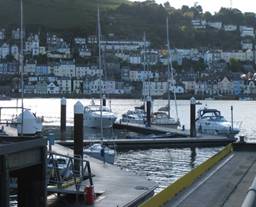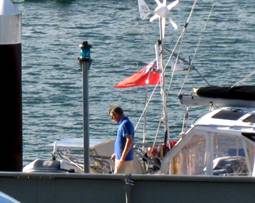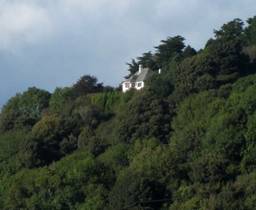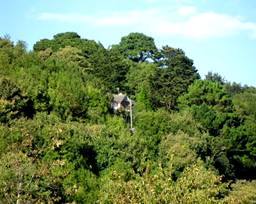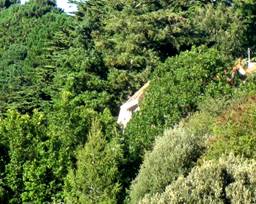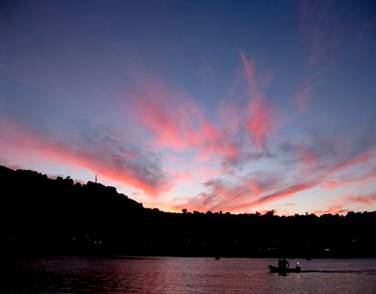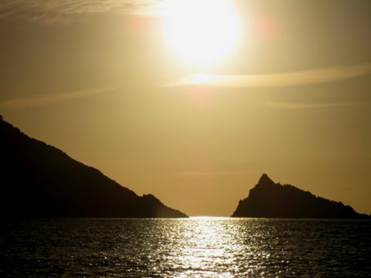Dartmouth to CHristchurch 18 09 10

|
The Adventures of Dream On – The Journey Home to On
Friday 17th, we didn’t leave
Dream On in her berth at the
Darthaven
Last minute bosunage
Little houses peeping out of the trees, as at Port Launay.
A
late water taxi
and a gorgeous sunset over
During the last few days, we heard good news from The
next morning we arose at 6 am again, and this time we did leave, though
eventually not till 7.15. It was a beautiful morning, everything looked really
pretty and I got the lump I always get when I leave
arms, which curve around it and disappear it completely behind
Mewstone and the coast in the Dartmouth Approaches the apparently unbroken line of undulating wooded hills on
the shoreline.
The
winds were NW, but only a very weak F3. We, and a companion yacht going to Poole
or Notwithstanding, at the back of both our minds, was the fact that at the
other end of the voyage, we would be having to negotiate Poole Bay, with some
pot buoys and lots of ships racing about, or Christchurch Bay, littered with pot
buoys, often invisible even in daylight. And if we arrived after dark, we then
faced a pretty dark channel up river, snaking across the respective harbours
around the many shallows about in both places. Both rivers are dark as the
anchorage at Poole sits behind the Purbeck hills, and is bounded by wooded
islands on the other side, and We
passed the place in Lyme Bay where we have twice seen dolphins before, but no
dolphins, though I have to admit we’ve only seen them going, never coming back,
At about 2 o’clock the wind picked up to F3 occasionally 4, the tide turned with
us and gave us a knot, and we began sailing along at 7.5 knots, occasionally
7.8. This was a great relief as we were getting anxious about the time.
Admittedly we still had the engine on, but when we turned the engine off to
change fuel tanks, she was still going at 6.2 knots over the ground. We arrived
earlier than we expected at Portland Bill, Just after We
kept our speed up even after rounding Anvil Point, when we thought we might lose
either the wind or the tide. But the wind increased to F5 so the sails still
carried us along in the high 7s. We
thought we might make it and decided to go for The channel moves every year, sometimes quite radically. Fred turned slightly to port, aiming for the caravan site next to Mudeford Quay as he had some idea of where the channel was when we left earlier this year. Suddenly, the first channel marker popped out of the dark to starboard, and then we saw the red cans to port and, going slowly under engine only, soon we were in The Run – perfect. Relief flooded us but we knew it was no time to relax. The Run is a narrow channel running alongside the quay on one side and a finger of land coming from Hengistbury on the other. This finger of land is just big enough to house all the gaily coloured beach huts and encloses the harbour. The Run is the entrance to the harbour, which we had to cross to get to the river.
The channel turns at right angles to port at the end of The Run and runs close to the shore. I shone the light on the unoccupied boats, carrying adverts, always parked along in inner of the edge of the channel so Fred could see where to turn. The channel then bends sharply to starboard in front of the Ferry jetty and between moored boats. With the aid of the moon, now in a good position, and the searchlight, we managed to find the buoys and boats and negotiate between them. Just as we were about to turn, a slim long speedboat with low freeboard came racing up the channel and we let it go by first. Going to sea at that time of night in a fairly small speedboat? Don’t think I would but each to his own. The channel then bends again at right angles to starboard, before snaking across the harbour. We managed to find the other channel markers, which we were pleased to find out had reflective parts and we mostly negotiated the bends adequately. We may have been not totally in the channel at all times, but as the centreboards and rudders kick up if they hit anything, giving us a draught of 18” and it was high water, we told ourselves not to worry too much.. Nevertheless, we concentrated hard and passed a small motor boat grounded on one of the banks of shallows. Once we’d crossed the harbour, the channel was easy to see; the water and the moored boats on either side of the river reflected the moonlight beautifully. We turned 180 degrees at Chapman’s Pool, following the river down to Rossiters; and then took the left river fork down to our berth. As soon as I’d finished finding buoys with the torch, I’d had to put out the fenders and ropes pretty quickly, and stood ready to lasso the cleat. Then I saw another boat, a huge motor boat, in our place. Fred then said he’d seen it too; he was going to the other side and I should quickly change the fenders and ropes over to port. I wasn’t sure what it was he was going to the other side of – our pontoon, the finger of land it was on or the other fork in the river, but I just concentrated on changing the fenders and ropes as fast as I could, as I knew it wasn’t far. As I saw him starting to turn the boat around, I realised he was going for the other fork, and probably the moorings by the yard, where boats go for treatment. This involves doing a 3pt turn - there is not the hugest amount of turning room for a boat our size - while avoiding the boats moored on both sides of the river. The other fork is a bit narrower, a bit wigglier and again has boats moored on both sides. Fred asked me to check he was going to miss the boats nearest the bow as he turned. Running across the deck with a fender, I stopped to check quickly, shouted he would, if he kept on turning and carried on. I’d got 3 fenders down the side, but before doing the 2 stern ones, I thought I’d get the bow line ready, cos the fenders wouldn’t be any use without. I’d just done it when Fred shouted, unknowing, ‘Get the bow line on, we’re there.’ I was glad I had, and after Fred avoided a randomly parked dinghy, and I had checked Fred had finished manoeuvring – which he had done very smoothly – I lassoed a post, tied it off and stepped off to take the stern line while Fred got the stern in and tied on the remaining fenders. And we were home. Whew! It
was now 9.30, a bit later than hoped, partly due to our slow careful pace from
|
